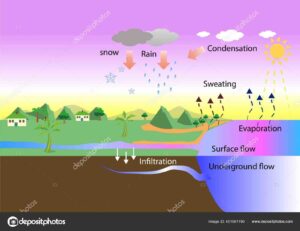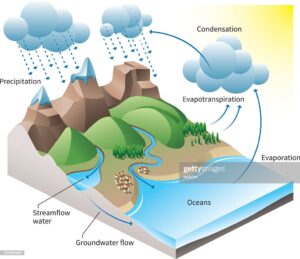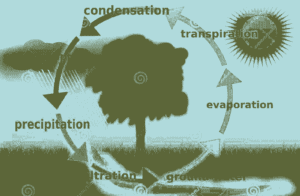What is water cycle?
Table of Contents
Have you heard of the facts of the water cycle? According to dictionary.com, the water cycle is the movement of water on, above, and below the surface of the earth. Let’s find out more about this interesting cycle on this blog.
This blog is about the water cycle, which is one process of the hydrologic cycle. This process is composed of the storage of the water in the atmosphere, the precipitation of the water, the water flow in the land, and the collection of the water in the sea.
The water cycle is a global water cycle consisting of the processes by which water circulates between the land, atmosphere, and ocean in the earth’s atmosphere. The water cycle involves the evaporation of water from oceans, seas, and other large bodies of water, such as rivers, lakes, and moisture in the air, followed by precipitation, which forms rivers, lakes, etc.
The water cycle is driven by energy from the Sun, both directly and through the evaporation of water from the land surface. The latter is a key component of the water cycle, as the evaporation.

Water cycle model
The water cycle is a simple model that describes evaporation and condensation. The water cycle is also called the hydrological cycle. It describes the movement of water through the atmosphere, oceans, land, and back into the atmosphere again. Water constantly evaporates (changes from a liquid to a gas) from the ocean and land. It then rises into the atmosphere as water vapor.
The water cycle is the continuous circulation of water on, above, and below the surface of the Earth. Solar energy drives the evaporation of water from oceans, lakes, moisture in the soil, and even the air, which cools and condenses to form clouds. The clouds are then carried by winds over land, where they discharge rain, snow, or hail onto the surface. The water then infiltrates the soil, streams, rivers, and lakes and follows a complex cycle of evaporation, movement through the ground, filtering through the earth, and re-evaporation into the atmosphere.
Water cycle project
The water cycle is the continuous movement of water on, above, and below the surface of the Earth. Water changes states between liquid, vapor, and ice, with the water molecules, constantly moving, yet always staying in the same system. The water cycle is also known as the hydrologic cycle. The water goes through different places and changes state several times. It all depends on how much water is in the air, how much water is on the ground, and how much water is in the lakes and oceans.

Water cycle explanation
The water cycle, also known as the hydrologic cycle or the hydrological cycle, describes the continuous movement of water on, above, and below the surface of the planet. Water changes states among liquid, vapor, and ice within the hydrosphere, and proceeds to cycle back into the atmosphere, land, and living things.
The water cycle involves the exchange of energy, which leads to temperature changes. For instance, when water evaporates, it takes up energy (the latent heat of vaporization) from its surroundings and cools the environment. When it condenses, it releases energy and warms the environment.
The Importance of the Water Cycle
Water is a basic necessity for the survival of all living creatures on the planet and the water cycle is a natural phenomenon that is responsible for the circulation of water around the planet.
The water cycle is a continuous cycle of evaporation, condensation, precipitation, and runoff. Water is constantly evaporating, but it is also constantly being taken up by plants and animals and it is being used by humans for various purposes such as drinking, farming, and swimming.

Hydrological Cycle
The hydrological cycle is the continuous movement of water on, above, and below the surface of the earth. It describes the processes by which water is redistributed within the hydrosphere, between the atmosphere, the terrestrial surface, and the oceans.
Water is constantly evaporating from the oceans, lakes, and other sources as water vapor. Water vapor is transported by circulatory currents such as winds, or by the water cycle. Evaporation leads to precipitation, which runs off the land’s surface or the ocean’s surface, infiltrates the ground as groundwater or sub-surface flow, and comes back to the surface again in springs, streams, rivers, and lakes.
As precipitation falls, it may also evaporate directly from the land’s surface, creating a cloud. When these tiny droplets of water evaporate, they cool the air around them, which may cause precipitation.
The global atmospheric water cycle
The global atmospheric water cycle is one of the most important cycles of the planet. Water is vital for life, but it’s also vital for the planet as it is the driving force behind many of the weather phenomena on Earth.
Water is constantly moving around the planet, usually in the form of water vapor, but sometimes as liquid water, snow, or ice. This movement is known as the global atmospheric water cycle.
Water is constantly evaporating from the oceans, lakes, rivers, wetlands, and other water bodies. It then travels through the atmosphere as water vapor. Here, it is largely determined by the temperature and pressure and changes from a gas to a liquid by releasing or absorbing heat energy. This is known as condensation.
When the water vapor reaches a certain level in the atmosphere, it cools and condenses. This is known as saturation. The water vapor then forms clouds and is released in the form of precipitation such as rain, snow, or hail. This precipitation eventually falls to the ground, and the water cycle begins again.
Human Water Cycle
It is no secret that humans require water to survive. It is also no secret that humans make up a large part of the water cycle. In fact, humans start out like water and will return to water once we die. Our bodies are mostly composed of water, our brains are more than 70% water, and we are even 70% water while we are on this planet. Water is an essential need for humans and our consumption of water is essential to the water cycle.
Human domination of the global water cycle absent
The human domination of the global water cycle is so strong that it prevents the Earth from cooling. This is according to scientists from the Potsdam Institute for Climate Impact Research (PIK).
Earth system model simulations show that the water cycle and thus the climate are dominated by human activities. Wind patterns and clouds over the Pacific Ocean have changed. The new pattern causes the warm water to accumulate in the western Pacific and thus prevents the Earth from cooling and natural recovery from the ongoing warming.
How Is Climate Change Impacting the Water Cycle?
According to the Intergovernmental Panel on Climate Change (IPCC), climate change is happening and the world is warming. The IPCC is an organization that was formed to provide objective scientific information on climate change for policymakers and others.
The IPCC has stated that there is a warming trend in the global climate and that this warming is “unequivocal.” In 2012, the IPCC released its Fourth Assessment Report on Climate Change, which found that the global climate is warming as a result of human activity. This report also stated that human activity is responsible for the global warming we are experiencing.
Mission to Mars 2020 Nasa | About brilliant NASA

